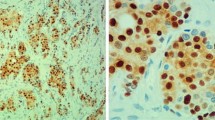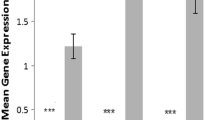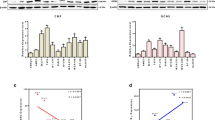Abstract
ATM protein kinase plays a critical role in maintaining genome integrity by activating a biochemical chain reaction that in turn leads to cell cycle checkpoint activation and repair of DNA damage. Cyclin D1 acts in regulating the G1 phase of the cell cycle. Experimental and clinical studies suggest them to be involved in transformation and tumour progression. To elucidate the role of ATM and cyclin D1 expression in sporadic breast cancer, we investigated the possible link between their RNA expression levels in ductal carcinoma and normal adjacent versus normal breast tissues measured by Taqman real-time PCR in 119 breast tissues. Results showed that cyclin D1 over-expressed in 51.4% of breast tumours, whereas ATM expression was down regulated in 55% of breast tumours compared to both normal adjacent and normal controls (P ≤ 0.01). Cyclin D1 expression in adjacent normal and normal tissues was not significantly differed, whereas ATM expression in normal adjacent was lower than normal control (P ≤ 0.01). Over-expression of cyclin D1 correlated with ER+ and/or PR+ (oestrogen/progesterone receptor) status, whereas it mostly under-expressed in HER2+ (human epidermal growth factor 2) tumours. ATM under-expression was more observed in triple-negative tumours (ER−, PR− and HER2−). Our results indicated that reduced expression of the ATM and aberrant cyclin D1 expressions may contribute to the development and/or malignant progression of breast carcinomas also the latter could be involved in the regulation of hormone sensitivity associated with ER and PR.



Similar content being viewed by others
References
Finnish Cancer Registry. Cancer in Finland 2004 and 2005. Cancer statistics of the national research and development centre for welfare and health. Cancer Society of Finland Publication No. 72. Helsinki; 2007.
Parkin DM. International variations. Oncogene. 2004;23:6329–40.
Lin Y, et al. Active smoking, passive smoking and breast cancer risk: findings from the Japan collaborative cohort study for evaluation of cancer risk. J Epidemiol. 2008;18:77–83.
Mousavi SM, et al. Breast cancer in Iran: an epidemiological review. Breast J. 2007;13:383–91.
Ministry of Health and Medical Education. Iranian annual national cancer registration report 2005–2006. Ministry of Health and Medical Education, Office of Deputy Minister for Health, Center for Disease Control and Prevention, Cancer Office: Tehran, Iran; 2007.
Behjati F, et al. Prognnostic value of chromosome 1 and 8 copy number in invasive ductal breast carcinoma among Iranian woman: an interphase FISH analysis. Pathol Oncol Res. 2005;11:157–63.
Najafi M, Ebrahimi M, Kaviani A, Hashemi E, Montazeri A. Breast conserving surgery versus mastectomy: cancer practice by general surgeons in Iran. BMC cancer. 2005;5:35–39.
Peters MG, et al. Prognostic value of cell cycle regulator molecules in surgically resected stage I and II breast cancer. Oncol Rep. 2004;12:1143–50.
Malumbres M, Barbacid M. Cell cycle, CDKs and cancer: a changing paradigm. Nat Rev Cancer. 2009;9:153–66.
Weinberg RA. The retinoblastoma protein and cell cycle control. Cell. 1995;81:323–30.
Sherr CJ. Cell cycle control and cancer. Harvey Lect. 2000;96:73–92.
Neuma E, et al. Cyclin D1 stimulation of estrogen receptor transcriptional activity independent of cdk4. Mol Cell Biol. 1997;17:5338–47.
Zwijsen RM, et al. CDK-independent activation of estrogen receptor by cyclin D1. Cell. 1997;88:405–15.
Petre CE, Wetherill YB, Danielsen M, Knudsen KE. Cyclin D1: mechanism and consequence of androgen receptor co-repressor activity. J Biol Chem. 2002;277:2207–15.
Landis MW, Pawlyk BS, Li T, Sicinski P, Hinds PW. Cyclin D1-dependent kinase activity in murine development and mammary tumorigenesis. Cancer Cell. 2006;9:13–22.
Poikonen P, et al. Cyclin A as a marker for prognosis and chemotherapy response in advanced breast cancer. Br J Cancer. 2005;93:515–9.
Keyomarsi K, et al. Cyclin E and survival in patients with breast cancer. N Engl J Med. 2002;347:1566–75.
Suzuki T, et al. Nuclear cyclin B1 in human breast carcinoma as a potent prognostic factor. Cancer Sci. 2007;98:644–51.
Berns E et al. Oncogene amplification and prognosis in breast cancer: relationship with systemic treatment. Gene (Amst.). 1995; 159:11–18.
Lee A, et al. Expression of c-erbB2, cyclin D1 and estrogen receptor and their clinical implications in the invasive ductal carcinoma of the breast. Jpn J Clin Oncol. 2007;37:708–14.
Cho EY, Choi YL, Han JJ, Kim KM, Oh YL. Expression and amplification of Her2, EGFR and cyclin D1 in breast cancer: immunohistochemistry and chromogenic in situ hybridization. Pathol Int. 2008;58:17–25.
Aaltonen K, et al. Cyclin D1 expression is associated with poor prognostic features in estrogen receptor positive breast cancer. Breast Cancer Res Treat. 2008;113:75–82.
Stoppa-Lyonnet D, et al. Inactivation of the ATM gene in T-cell prolymphocytic leukemias. Blood. 1998;91:3920–6.
Stankovic T, et al. Inactivation of ataxia telangiectasia mutated gene in B-cell chronic lymphocytic leukaemia. Lancet. 1999;353:26–9.
Khanna KK. Cancer risk and the ATM gene: a continuing debate. J Natl Canc Inst. 2000; 92:10.
Livak KJ, Schmittgen TD. Analysis of relative gene expression data using real-time quantitative PCR and the 2(−ΔΔCT) method. Methods. 2001;25:402–8.
Courjal F, et al. Cyclin gene amplification and overexpression in breast and ovarian cancers: evidence for the selection of cyclin D1 in breast and cyclin E in ovarian tumors. Int J Cancer. 1996;69:247–53.
Hosokawa Y, Arnold A. Mechanism of cyclin D1 (CCND1, PRAD1) overexpression in human cancer cells: analysis of allele-specific expression. Genes Chromosome Cancer. 1998;1:66–71.
Barnes DM, Gillett CE. Cyclin D1 in breast cancer. Breast Cancer Res Treat. 1998;52:1–15.
Kenny FS, et al. Overexpression of cyclin D1 messenger RNA predicts for poor prognosis in estrogen receptor-positive breast cancer. Clin Cancer Res. 1999;5:2069–76.
Bièche I, Olivi M, Noguès C, Vidaud M, Lidereau R. Prognostic value of CCND1 gene status in sporadic breast tumours, as determined by real-time quantitative PCR assays. Br J Cancer. 2002;86:580–6.
Bärlund M, Kuukasjärvi T, Syrjäkoski K, Auvinen A, Kallioniemi A. Frequent amplification and overexpression of CCND1 in male breast cancer. Int J Cancer. 2004;111:968–71.
Sutherland RL, Musgrove EA. Cyclins and breast cancer. J Mammary Gland Biol Neoplasia. 2004;9:95–104.
Bienvenu F, et al. Transcriptional role of cyclin D1 in development revealed by a genetic-proteomic screen. Nature. 2010;463:374–8.
Groshong SD, et al. Biphasic regulation of breast cancer cell growth by progesterone: role of the cyclin dependent kinase inhibitors, p21 and p27(Kip1). Mol Endocrinol. 1997;11:1593–607.
Wilcken NR, Prall OW, Musgrove EA, Sutherland RL. Inducible overexpression of cyclin D1 in breast cancer cells reverses the growth-inhibitory effects of antiestrogens. Clin Cancer Res. 1997;3:849–54.
Yang C, et al. Cyclin D1 enhances the response to estrogen and progesterone by regulating progesterone receptor expression. Mol Cell Biol. 2010;30:3111–25.
Takano Y, et al. Cyclin D1 overexpression in invasive breast cancers: correlation with cyclin-dependent kinase 4 and oestrogen receptor overexpression, and lack of correlation with mitotic activity. J Cancer Res Clin Oncol. 1999;12:505–12.
Spyratos F, et al. CCND1 mRNA overexpression is highly related to estrogen receptor positivity but not to proliferative markers in primary breast cancer. Int J Biol Markers. 2000;15:210–4.
Utsumi T, et al. Correlation of cyclin D1 mRNA levels with clinico-pathological parameters and clinical outcome in human breast carcinomas. Int J Cancer. 2000;89:39–43.
Musgrove EA, Hui R, Sweeney KJ, Watts CK, Sutherland RL. Cyclins and breast cancer. J Mammary Gland Biol Neoplasia. 1996;1:153–62.
Umekita Y, Ohi Y, Sagara Y, Yoshida H. Overexpression of cyclinD1 predicts for poor prognosis in estrogen receptor-negative breast cancer patients. Int J Cancer. 2002;98:415–8.
Hwang TS, Han HS, Hong YC, Lee HJ, Paik NS. Prognostic value of combined analysis of cyclin D1 and estrogen receptor status in breast cancer patients. Pathol Int. 2003;53:74–80.
Boström P et al. Analysis of cyclins A, B1, D1 and E in breast cancer in relation to tumour grade and other prognostic factors. BioMed Central BMC Res Notes. 2009; 2:140.
Kairouz R, et al. ATM protein synthesis patterns in sporadic breast cancer. Mol Pathol. 1999;52:252–6.
Angèle S, et al. Abnormal expression of the ATM and TP53 genes in sporadic breast carcinomas. Clin Cancer Res. 2000;6:3536–44.
Angèle S, Treillex I, Taniere P, Bremond A, Hall J. Altered expression of DNA double strand break detection and repair proteins in breast carcinomas. Histopathology. 2003;43:347–53.
Ding SL, et al. Abnormality of the DNA double-strand-break checkpoint/repair genes, ATM, BRCA1 and TP53, in breast cancer is related to tumour grade. Br J Cancer. 2004;90:1995–2001.
Honrado E, et al. Immunohistochemical expression of DNA repair proteins in familial breast cancer differentiate BRCA2-associated tumors. J Clin Oncol. 2005;23:7503–11.
Cuatrecasas M, et al. ATM gene expression is assocaiated with differentiation and angiogenesis in infiltrating breast carcinomas. Histol Histopathol. 2006;21:149–56.
Ye C, et al. Expression patterns of the ATM gene in mammary tissues and their associations with breast cancer survival. Cancer. 2007;109:1729–35.
Agrawal A, Murphy RF, Agrawal DK. DNA methylation in breast and colorectal cancers. Mod Pathol. 2007;20:711–21.
Dworkin AM, Huang Tim H-M, Toland AE. Epigenetic alterations in the breast: implications for breast cancer detection, prognosis and treatment. Semin Cancer Biol. 2009;19:165–71.
Vo QN, et al. The ATM gene is a target for epigenetic silencing in locally advanced breast cancer. Oncogene. 2004;23:9432–7.
Kontorovich T, Cohen Y, Nir U, Friedman E. Promoter methylation patterns of ATM, ATR, BRCA1, BRCA2 and p53 as putative cancer risk modifiers in Jewish BRCA1/BRCA2 mutation carriers. Breast Cancer Res Treat. 2009;116:195–200.
Treilleux I, et al. The molecular causes of low ATM protein expression in breast carcinoma; promoter methylation and levels of the catalytic subunit of DNA-dependent protein kinase. Histopathology. 2007;51:63–9.
Tommiska J, et al. The DNA damage signalling kinase ATM is aberrantly reduced or lost in BRCA1/BRCA2-deficient and ER/PR/ERBB2-triple-negative breast cancer. Oncogene. 2008;27:2501–6.
Jeggo PA, Carr AM, Lehmann AR. Splitting the ATM: distinct repair and checkpoint defects in ataxia-telangiectasia. Trends Genet. 1998;14:312–6.
Acknowledgments
This work was supported by Research Department of the Faculty of Medical Sciences, Tarbiat Modares University. The authors would like to thank Mrs Esmaili and Miss Abdoli for their technical assistance and all patients contributed in this study.
Author information
Authors and Affiliations
Corresponding author
Rights and permissions
About this article
Cite this article
Salimi, M., Mozdarani, H. & Majidzadeh, K. Expression pattern of ATM and cyclin D1 in ductal carcinoma, normal adjacent and normal breast tissues of Iranian breast cancer patients. Med Oncol 29, 1502–1509 (2012). https://doi.org/10.1007/s12032-011-0043-5
Received:
Accepted:
Published:
Issue Date:
DOI: https://doi.org/10.1007/s12032-011-0043-5




